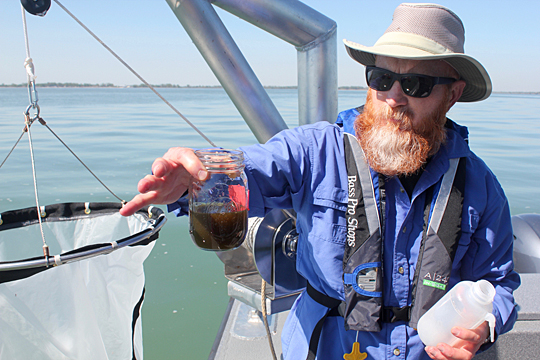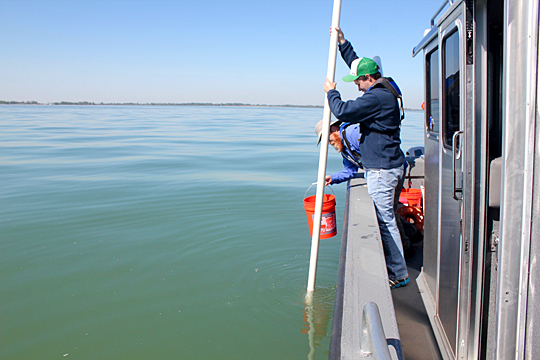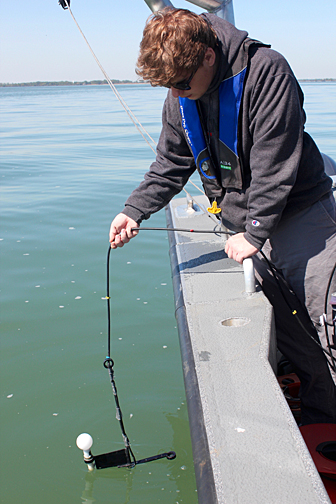The long red-bearded scientist didn’t lose his smile or his mesh-vented hat once during the six hours and 40 miles on board The University of Toledo Lake Erie Center’s 28-foot research vessel.
“I love being out on the water,” said Dr. Thomas Bridgeman, UT algae researcher and associate professor of ecology. “That’s why I got into the business.”

Dr. Thomas Bridgeman held a jar containing concentrated algae pulled up from Lake Erie using the plankton net hanging on the side of the boat. In mid-May, the golden algae called diatoms is good for the lake, according to the researcher.
His weapon of choice is information gathered by boat and by buoy.
“We give the early warning to the water treatment plant operators,” Bridgeman said. “Algal blooms start here in Maumee Bay. We’re looking to find if there is anything in the bay heading to the city of Toledo’s water intake pipe that pumps raw lake water to the plant.”
The intake, or what’s known as the crib, was the first of eight spots his team dropped anchor to collect samples and other data in mid-May. It marked the first sampling day of the year and the first trip for UT student Zach Swan, who is working as a technician for the summer.“This is a big bay,” said the rookie, a junior majoring in environmental studies.
Before departing the dock at Meinke Marina, Bridgeman knew they wouldn’t find any toxins on the year’s inaugural ride.

Zach Swan, a junior majoring in environmental studies, left, Ken Gibbons, research associate at the Lake Erie Center, center, and Dr. Thomas Bridgeman Toledo aboard the center’s 28-foot research vessel.
Using a rope and pulley on the starboard side, Bridgeman lowered a plankton net six meters to the lake bottom and towed to the surface golden algae called diatoms.
“This is quite a diatom bloom,” Bridgeman said as he concentrated the sample from a few thousand liters down to a few tablespoons. “It’s the good algae, not the bad, bright green algae. This is beneficial-like grass of the lake.”
Ken Gibbons navigated the waters between each sampling location on the bright spring day with the help of the boat’s state-of-the-art GPS system.“It’s interesting to be part of something relevant,” said the Lake Erie Center research associate, who graduated from UT last year with a master’s degree in biology.
During each stop, Gibbons also had massive straw duty. He stuck a long, white tube down to the bottom of the lake, pulled it up, and emptied it into an orange bucket.

Ken Gibbons pulled up a water sample using a a long, white tube that reaches the lake bottom. The water was emptied into the orange bucket held by Dr. Thomas Bridgeman.
Gibbons transferred that water into bottles that then rode back to the lab in a cooler.
“I think of the algae as an agricultural crop,” Bridgeman said. “Every year is different. What is the problem going to be this year?”
The city of Toledo issued a ‘Do Not Drink’ advisory in 2014 for three days due to the level of the toxin microcystin in the drinking water. Last summer, the algal bloom nearly reached a record size, but did not impact the public water supply.

This photo of the GPS screen on board the UT research vessel showed the 40-mile diamond route on a map.
At least two months ahead of the 2016 algal bloom season, the UT team — which includes Brenda Snyder, the former chief chemist of Toledo’s water treatment plant — already has begun testing the waters for phosphorous and nitrogen.
The farthest and deepest sampling location is off the northwest corner of West Sister Island.
“Almost no diatoms here,” Bridgeman said.
The weather conditions were so vividly clear on the ride toward Monroe, Mich., the team could see wind turbines in Canada, approximately 20 miles away.
The sampling spot near the end of the shipping channel 10 miles east of the Monroe power plant had the greatest clarity, according to the Secchi disk attached to a rope. The crew recorded how far below the surface the black-and-white pie graph disappeared from view: 270 centimeters.

Zach Swan lowered the light meter into the water to measure how far light penetrates into the water.
“Algae can’t grow without light,” Bridgeman said. “The murkier the water, the less light there is to grow algae.”
Heading back toward Toledo past Turtle Island and Point Place, the team reached the UT remote sensor buoy that will stay in place through at least August. Bridgeman pulled up live data from the buoy on his cell phone.
“There is no blue-green algae to speak of yet,” Bridgeman said. “We will mainly look for the blue-green algae pigment and when it starts to rise.”
The buoy is armed with a YSI EXO sonde, comprised of several probes to measure water quality parameters, including water temperature, oxygen levels and pH. It’s the same tool that Swan lowered to the lake floor at each sampling location.
“It’s exciting to have the opportunity to do this as a student,” Swan said. “My family lives in Toledo. They care about what we’re doing out here.”
After completing the diamond-shaped route through the western Lake Erie basin, the crew returned to the Lake Erie Center lab. Some of the test results were instantaneous. Others required processing.
“I plan to call the city water managers and let them know they’ve got a lot of diatoms out there,” Bridgeman said. “Diatoms can cause potential taste and odor problems in drinking water; however, there’s no issue with toxins.”